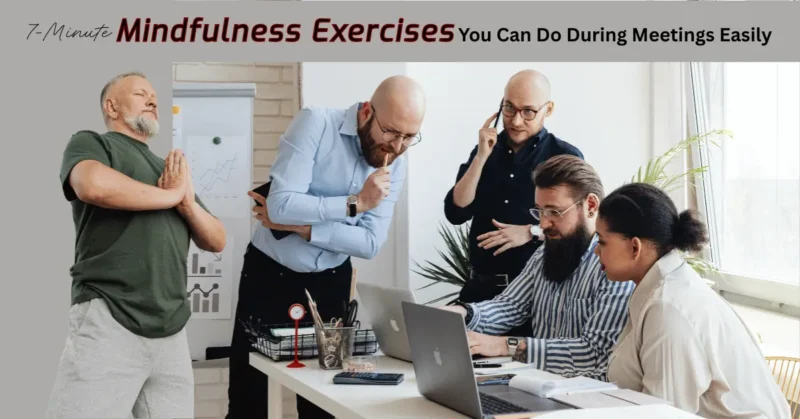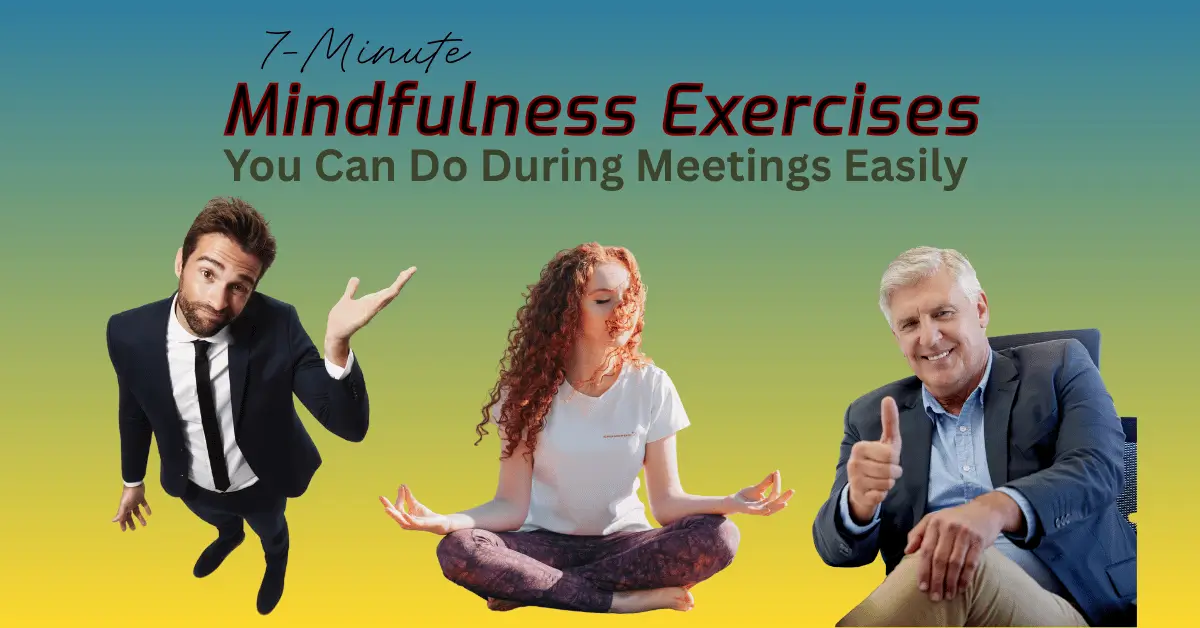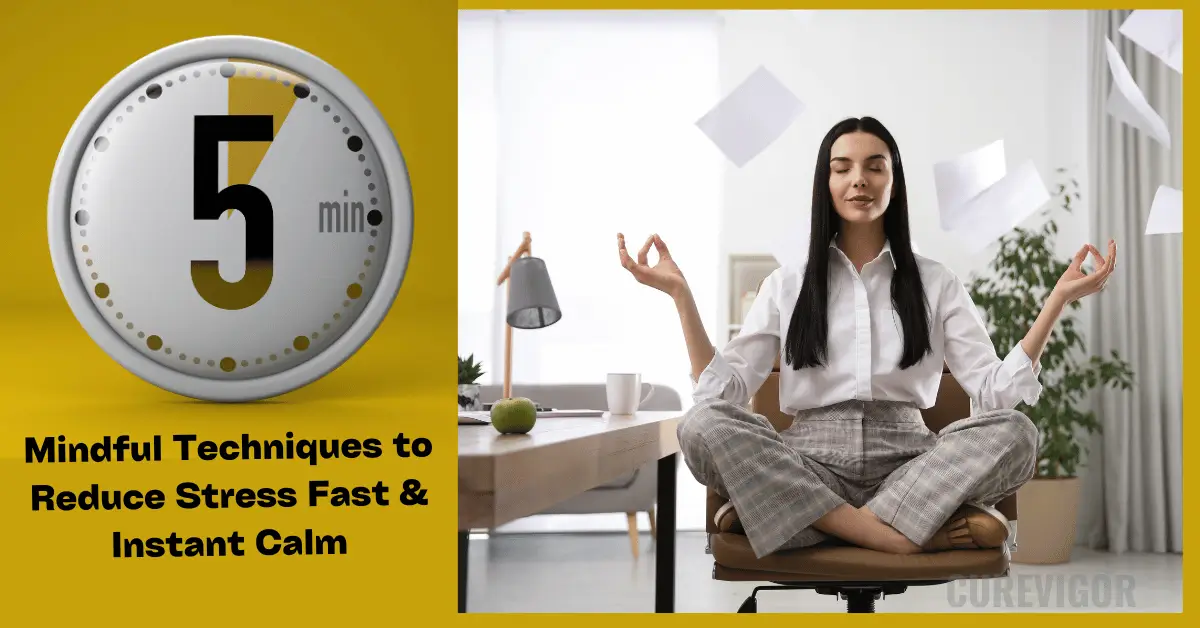Learn the best mindfulness exercises for busy professionals. These quick 7-minute practices help you stay centered, improve focus, and boost productivity during any meeting.
Thank you for reading this post, don't forget to subscribe!Meetings can drain your energy and attention, but it only takes a few minutes to reset your mind. With simple mindfulness exercises, you can stay calm, alert, and productive even during a hectic workday.
These 7-minute techniques fit smoothly into any meeting and help you stay at your best.
Bringing Mindfulness to the Workplace
In a busy workplace filled with messages, deadlines, and constant distractions, it can feel like there is no space to breathe.
Mindfulness exercises help you create that space. They give your mind a reset during the same moments that usually drain your energy.
You do not need to sit on a cushion or close your eyes for twenty minutes. During a meeting, you can practice mindfulness exercises and feel more focused, grounded, and productive.
The following simple mindfulness exercises fit easily into short breaks or even quiet moments during conversations.

All of them take roughly seven minutes or less. With consistency, they help reduce stress, sharpen focus, and build a calmer work culture.
Quick Mindfulness Exercises for Busy Professionals
Deep Breathing
Deep breathing helps you settle your attention and calm your nervous system. Start by inhaling slowly through your nose. Feel the air fill your lungs. Hold for a second or two, then release it through your mouth.
Let your shoulders drop as you exhale. Notice how your body softens. Let each breath slow your pace.
This is one of the most effective simple mindfulness exercises because it is discreet. You can practice it while listening, while waiting for your turn to speak, or while transitioning from one agenda point to the next.
The slow rhythm signals safety to your brain, lowering tension and clearing mental clutter.
To deepen the effect, try counting to four as you inhale, pausing briefly, and then counting to six on the exhale. The longer out-breath helps the mind settle. Even three rounds can shift your mindset from stressed to steady.
Body Scan
A body scan brings your attention back into the present by tuning in to physical sensations. Start with your feet. Notice how they rest on the floor. Move your awareness slowly upward.
Observe your calves, knees, thighs, hips, and lower back. Continue up through your stomach, chest, shoulders, neck, and face.
This mindfulness exercise does not require dramatic movement. It simply asks you to notice what is already there. You might find tension hiding in your jaw or a tight spot in your shoulders. Once you notice it, allow it to loosen.
Body scans can restore mental clarity during long meetings by drawing your focus inward for a brief reset. Even a thirty-second scan helps you return to the discussion with renewed attention.
Mindfulness Exercises for Improved Focus
Mindful Listening
Mindful listening helps you become a better communicator and a more engaged collaborator. Instead of thinking about what you will say next, tune in fully to the speaker. Pay attention to their words.
Notice their tone and rhythm. Watch their body language. Let yourself hear the message without judging or planning.
This mindfulness exercise strengthens workplace relationships and reduces misunderstandings. It tells people you value their ideas. It also improves your ability to stay present, which is essential for focus.

A helpful trick is to silently repeat a key phrase from the speaker while they talk. This keeps your attention anchored and prevents your thoughts from drifting.
Mindful listening transforms meetings from passive events into active moments of connection.
Mindful Walking
Mindful walking helps you boost energy and reset your mental state. You do not need a long hallway. Even a short walk to refill water or move between meeting rooms works.
As you walk, pay attention to the feeling of your feet touching the ground. Notice the pace of your steps. Feel the shift of weight from one foot to the other.
This exercise brings movement back into your day. It interrupts the stiffness that often comes from long hours of sitting.
It also helps you shake off mental tension. By the time you return to your meeting, your mind is sharper and your energy is higher.
Walking mindfully can be paired with deep breathing for even stronger focus. When both work together, you create a powerful grounding effect.
Mindfulness Exercises for Reduced Stress
Gratitude Reflection
Gratitude reflection is a simple mindfulness exercise that shifts your mindset toward positivity. Think of one or two things you appreciate right now.
They can be small. A warm coffee. A teammate who helped you earlier. A project that is finally moving forward.
This practice interrupts stress by reminding your brain of what is going well. It balances your perspective and softens the feeling of pressure.
Gratitude is a useful tool during difficult times at work since it activates brain regions associated with calmness and well-being.
You can practice gratitude reflection silently while someone else speaks or during a pause in the meeting. Over time, this becomes a habit that strengthens resilience.
More Simple Mindfulness Exercises You Can Do During Meetings
Mindful Posture Reset
Mindful posture reset helps you release tension and regain presence. Begin by noticing how you are sitting. Are your shoulders tight? Is your back rounding? Are you leaning too far forward?
Adjust your posture gently. Lift your chest. Let your shoulders fall. Lengthen your neck.
This small shift changes how your brain operates. When your posture opens, your breathing improves. Your thoughts settle. Your confidence grows. You feel more capable and more alert.
This exercise works well during long virtual meetings or conference calls. It is subtle yet provides immediate relief from stress.
Anchor Words
Anchor words help you steady your attention with a simple mental cue. Choose a word or short phrase that reminds you to stay present. Examples include “steady,” “here,” “focus,” or “calm now.”
Anchor words act as a mental reset button. When you notice your thoughts racing or drifting, repeat your chosen word silently. It pulls your attention back to the moment without anyone noticing.
This mindfulness exercise is ideal for high-pressure meetings or fast-moving conversations. It keeps your mind from becoming overwhelmed and helps you stay mentally organized.
How to Use Mindfulness Exercises Effectively During Meetings
Mindfulness exercises work best when you make them a part of your routine. The more often you practice them, the faster your mind returns to a grounded state when stress rises.
Use them at natural pauses.
Short breaks between agenda items are perfect moments for a breath or a posture reset. During virtual meetings, turn off your camera for thirty seconds if needed and walk mindfully for a moment.
Stay subtle
Mindfulness does not need to be visible. Deep breathing, anchor words, or a brief body scan can be done without drawing any attention. These small habits add up.
Start with one exercise at a time.
Pick the one that feels easiest. Practice it every day for a week, just during meetings. Once it becomes natural, add a second. This slow build helps you stick with the habit.
Match the exercise to the moment.
If you feel tense, try deep breathing.
If you feel distracted, use anchor words or mindful listening.
If you feel tired, choose mindful walking.
If you feel overwhelmed, use a gratitude reflection.
Different situations call for different tools. Use what helps most in the moment.
Encourage team mindfulness
You can introduce a one-minute breathing space at the start of team meetings. Many teams already use this simple routine to help everyone settle in. It improves meeting quality and builds a calmer team culture.
FAQ About Workplace Mindfulness
Q. What is a simple mindfulness exercise that can be done in 5 minutes?
A simple mindfulness exercise that fits into five minutes is slow, mindful breathing. Sit comfortably and inhale through your nose while counting to four. Hold briefly, then exhale to a count of six.
Observe how your chest rises and falls as you breathe. Pay attention to any areas of tension and let them soften.
This short practice settles your mind, slows your thoughts, and prepares you for the next task with more clarity.
Q. What are the 7 C’s of mindfulness?
The 7 C’s of mindfulness describe attitudes that support a calm and steady practice. They are curiosity, compassion, courage, calmness, creativity, clarity, and confidence.
Each one helps you approach your experiences with less judgment and more openness. Practicing them teaches you to respond rather than react. They also help build emotional resilience.
When these qualities guide your mindset, mindfulness becomes easier to maintain in daily life.
Q. What are the 5 R’s of mindfulness?
The 5 R’s of mindfulness provide a simple structure for staying present. They are Recognize, Relax, Return, Reframe, and Respond. Recognize what you are feeling or thinking.
Relax the body so tension releases. Return your attention to the present moment. Reframe the situation with a calmer perspective.
Respond with intention instead of impulse. These steps help you manage stress and keep your mind steady.
Q. What is a good beginner mindfulness exercise?
A good beginner mindfulness exercise is observing your breath for one or two minutes.
Sit still and focus your attention on the air moving in and out of your body. If your thoughts wander, guide them back without judgment.
This exercise is simple, quiet, and grounding. It teaches focus and awareness. With consistent practice, it builds a strong foundation for deeper mindfulness habits.
Q. What is the 3-3-3 rule in mindfulness?
The 3-3-3 rule in mindfulness helps you interrupt stress by engaging your senses. Look around and name three things you can see.
Listen and identify three sounds you can hear. Move three parts of your body, such as your shoulders, fingers, or ankles.
This technique pulls your attention away from racing thoughts. It brings you back to the present and helps your mind reset. Many people use it during stressful workdays or moments of overwhelm.
Q. Is the 5-4-3-2-1 method effective?
The 5-4-3-2-1 method is effective because it grounds you through sensory awareness.
You can see five things, feel four, hear three, smell two, and taste one. This sequence keeps your focus on the real world rather than on anxious thoughts.
It slows your heart rate and creates a sense of stability. It is simple, quick, and easy to use anywhere. Many people rely on it to calm nerves during meetings, travel, or stressful transitions.
Conclusion
Mindfulness exercises offer simple ways to stay grounded in a fast-paced workplace.
You can practice them quietly during meetings, before difficult conversations, or anytime you feel tense or distracted.
They help you think more clearly, communicate more effectively, and work with more ease.
When you use these seven-minute exercises regularly, they become tools you can count on. They help you handle stress with more confidence and show up to work with more clarity.
These small mindfulness moments create long-lasting change. They help you stay steady in a busy world and bring your best self to every meeting.
Stay consistent and try one of these exercises today. A calmer, more focused workday starts with a single mindful moment. Take that step now and feel the difference.
Read more articles on Health and Balance.
You might like:


